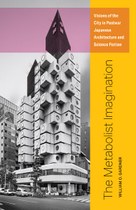Places: The Metabolist Imagination
 Architecture and science fiction are interrelated forms. The author of a plan or a story imagines an intervention in the environment and a change in the lives of its inhabitants, which is revealed through narrative consequences. A sprawling horizontal city remapped onto giant, vertical, spiral structures, with recyclable, movable housing pods plugging into the helix framework. Industrial cities floating off the Pacific coast of Japan, linking, expanding, shrinking, and shifting their locations according to economic demands. The family home reconceived as the mutual docking of capsules belonging to migratory, autonomous individuals. Architecture becoming liquid, invisible, indistinguishable from images. A second, virtual city overlapping the physical city. Some of these are architectural proposals, and some are works of fiction. Placing them side by side helps us see modern architects as authors of narrative, while appreciating SF writers for their role in imagining the interactions of built and natural environments and the consequences for human lives.
Architecture and science fiction are interrelated forms. The author of a plan or a story imagines an intervention in the environment and a change in the lives of its inhabitants, which is revealed through narrative consequences. A sprawling horizontal city remapped onto giant, vertical, spiral structures, with recyclable, movable housing pods plugging into the helix framework. Industrial cities floating off the Pacific coast of Japan, linking, expanding, shrinking, and shifting their locations according to economic demands. The family home reconceived as the mutual docking of capsules belonging to migratory, autonomous individuals. Architecture becoming liquid, invisible, indistinguishable from images. A second, virtual city overlapping the physical city. Some of these are architectural proposals, and some are works of fiction. Placing them side by side helps us see modern architects as authors of narrative, while appreciating SF writers for their role in imagining the interactions of built and natural environments and the consequences for human lives.



